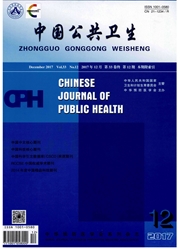

 中文摘要:
中文摘要:
目的将与风险探索发炎和 endothelial 机能障碍的关系到心血管的疾病(CVD ) 。方法血压,身体重量,身体高度,腰圆周和生活方式风险因素包括高敏感的C反应的蛋白质( hsCRP )在发炎和 endothelial 机能障碍的中国,和 biomarkers 的内部蒙古在 2589 个参加者之中被测量并且学习,可溶的细胞间的粘附 molecule-1 ( sICAM-1 ),可溶的 E-selectin ( sE-selectin ),和血管收缩素 II 被调查。有为比那些的 hsCRP, sE-selectin 和没有这的 sICAM-1 高级的有的 CVD 的新陈代谢的风险因素的结果题目冒险因素(所有 P < 0.05 ) 。所有 biomarkers 的层次断然并且显著地在这些题目之中与新陈代谢的风险因素的聚集增加了(为趋势的所有 P < 0.001 ) 。从 multivariate 分析的数据出现了那有 hsCRP 的高水平的参加者[机会比率(或) :1.96, 95% 信心间隔(CI ) :1.52-2.53 ] , sE-selectin (或:1.35, 95% CI:1.051.72 ) ,并且血管收缩素 II (或:1.81, 95% CI:1.402.33 ) 是更可能的得高血压;有 hsCRP 的高水平的参加者(或:2.33, 95% CI:1.852.94 ) , sE-selectin (或:1.24, 95% CI:1.001.54 ) ,并且 sICAM-1 (或:1.70, 95% CI:1.302.22 ) 是更可能的与 hsCRP 的高水平开发 dyslipidemia,和那些(或:2.95, 95% CI:2.273.83 ) 并且 sICAM-1 (或:2.80, 95% CI:2.063.80 ) 是更可能的开发多糖症。发炎和 endothelial 机能障碍的结论 Biomarkers 独立为 CVD 与相关新陈代谢的风险因素被联系。并且适当措施应该被采取控制发炎并且为 CVD 与不同新陈代谢的风险因素在个人之中改进 endothelial 功能。
 英文摘要:
英文摘要:
Objective To explore the relationship of inflammation and endothelial dysfunction with risks to cardiovascular disease (CVD). Methods Blood pressure, body weight, body height, waist circumference and lifestyle risk factors were measured and studied among 2589 participants in Inner Mongolia of China, and biomarkers of inflammation and endothelial dysfunction including high-sensitivity C-reactive protein (hsCRP), soluble inter-cellular adhesion molecule-1 (slCAM-1), soluble E-selectin (sE-selectin), and angiotensin II were investigated. Results Subjects with metabolic risk factors for CVD had higher levels of hsCRP, sE-selectin and slCAM-1 than those without such risk factors (all P〈O.05). Levels of all biomarkers positively and significantly increased with aggregation of the metabolic risk factors among the subjects (all P for trend 〈0.001). Data from the multivariate analysis showed that participants with high levels of hsCRP [odds ratio (OR}: 1.96, 95% confidence interval (CI): 1.52-2.53], sE-selectin (OR: 1.35, 95% Cl: 1.05-1.72), and angiotensin II (OR: 1.81, 95% CI" 1.40-2.33) were more likely to develop hypertension; participants with high levels of hsCRP (OR: 2.33, 95% CI: 1.85-2.94), sE-selectin (OR: 1.24, 95% CI: 1.00-1.54), and slCAM-1 (OR: 1.70, 95% CI: 1.30-2.22) were more likely to develop dyslipidemia, and those with high levels of hsCRP (OR: 2.95, 95% CI: 2.27-3.83) and slCAM-I(OR: 2.80, 95% CI: 2.06-3.80) were more likely to develop hyperglycemia. Conclusion Biomarkers of inflammation and endothelial dysfunction were separately associated with relevant metabolic risk factors for CVD. And appropriate measures should be taken to control inflammation and improve endothelial function among individuals with different metabolic risk factors for CVD.
 同期刊论文项目
同期刊论文项目
 同项目期刊论文
同项目期刊论文
 Association of obesity and biomarkers of inflammation and endothelial dysfunction in adults in Inner
Association of obesity and biomarkers of inflammation and endothelial dysfunction in adults in Inner Association of elevated inflammatory and endothelial biomarkers with prehypertension among Mongolian
Association of elevated inflammatory and endothelial biomarkers with prehypertension among Mongolian Biomarkers of inflammation, endothelial dysfunction and insulin resistance in adults of Inner Mongol
Biomarkers of inflammation, endothelial dysfunction and insulin resistance in adults of Inner Mongol Relationship between white blood cell count at admission and short term outcome in patients with acu
Relationship between white blood cell count at admission and short term outcome in patients with acu Biomarkers of inflammation and endothelial dysfunction and risk of hypertension among Inner Mongolia
Biomarkers of inflammation and endothelial dysfunction and risk of hypertension among Inner Mongolia 期刊信息
期刊信息
